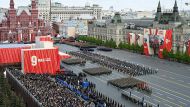MINSK, 30 April (BelTA) – The Belarusian economy has recovered and demonstrated a 0.9% GDP growth in Q1 2021 in comparison with Q1 2020. Belarus' GDP is expected to grow by 1.5-1.8% in H1 2021. The figures are mentioned by an economic review prepared by Belarusian Economy Minister Aleksandr Chervyakov for the Ekonomicheskaya Gazeta newspaper, the press service of the Belarusian Economy Ministry told BelTA.
The Belarusian economy continued growing in March. The GDP growth rate accelerated by 0.1% in comparison with January-February, with Q1 2021 growth at 0.9%. The economy did better than projected: previously the Economy Ministry expected the GDP volume to stay on par with Q1 2020.
According to Aleksandr Chervyakov, the effect of comparison with a low baseline of 2020 can be interpreted differently. On the one hand, COVID-19 had virtually no effect on the Belarusian economy in that period. On the other hand, other external negative factors were at play (low volumes of oil import and the absence of potash contracts). Taking into account the small decrease in the GDP in 2020 (0.9%), it is a signal that the economy is transitioning from recovery to growth. Without macroeconomic misbalance. Economic recovery began in Q3 2020. It was fostered by the government's decision to keep enterprises working and by support measures stipulated by a number of presidential decrees and other documents. As a result, the operating enterprises became the foundation that enabled recovery growth and allowed exploiting the improvement of the foreign market situation due to the relaxing of antivirus measures in the countries Belarus trades with. Branches of the Belarusian economy performed without obvious failures. They made their contributions to the gross added value, Aleksandr Chervyakov stressed.
The manufacturing sector is the main driver of this growth (109.2%). High pace was demonstrated not only in the raw materials sector (oil refining – 147.1%, potash fertilizers – 142.9%) but the branches that make investment goods. The output of the main kinds of products increased virtually across the board.
The growth of the gross added value of the mechanical engineering industry accelerated in Q1 2021 to 117.8%. The production of harvesters, loaders, haul trucks, and tractors increased. The chemical industry continues developing steadily, including thanks to the accelerated production of medications.
The rapid growth of the gross added value of electric equipment (11.4%) was fueled by the production of household refrigerators and freezers, washing machines, electric stoves.
Cold weather and the resulting additional demand for energy goods gave a positive impulse to the Belarusian economy in Q1 2021. An increase in the consumption of electricity and heat contributed to the industrial output growth. In other words, growth was registered in the economy branches, which have been earmarked as economic growth drivers for the new five-year term. As of 1 April 2021 the stock in storage was at its lowest since 2013 – 61.2%. Over 60% of the manufacturing sector's output was exported. “The processing of local raw materials, including agricultural ones, is another branch, which potential we have yet to fully explore,” the economy minister said.
In his words, the pandemic had a softer impact on food output (1.6% up in Q1 2021). The output of sausages, vegetable oils, and hard cheese increased.
The official said: “Speaking about the food industry as a whole, I should point out its seasonal nature. For instance, the development of the sugar industry depends on the time of the year and the situation on foreign markets. At present international prices for sugar in U.S. dollars exceed those registered in March 2020 by over 30% due to the lower sugar supply this season. The financial state of our sugar refineries will gradually improve thanks to such dynamics. Financial indicators of the manufacturing sector have improved. Sales profitability totaled 8.2%, 0.6% up from January-February 2020. Net profit totaled Br815 million while losses in January-February 2020 were as high as Br1.3 billion.”
Results of the Economy Ministry's latest polls of heads of industrial enterprises testify to the steady positive trend in the manufacturing sector. The respondents are positive about near future from the point of view of the demand for their products, the workload of manufacturing facilities, and so on. Positive dynamics is largely attributed to “cyclical” optimism after a considerable decline last year. The order portfolio allows planning how to preserve the current level of employment. Most of the respondents (80%) believe that the number of workers at the enterprises will not change in the near future. The number of the respondents expecting the number of workers to rise exceeds the number of respondents expecting a decline (14% against 5%).













